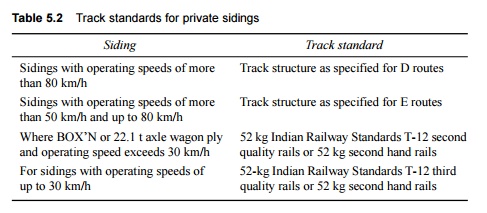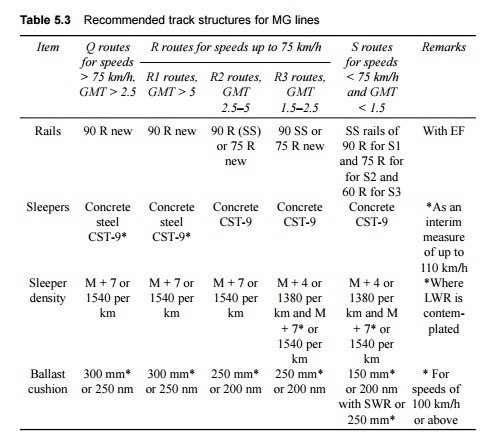Chapter: Civil : Railway Airport Harbour Engineering : Railway Engineering : Track and Track Stresses
Requirements of a Good Railway Track
Requirements of a Good Railway Track
A permanent way or
track should provide a comfortable and safe ride at the maximum permissible
speed with minimum maintenance cost. To achieve these objectives, a sound
permanent way should have the following characteristics.
(a) The
gauge should be correct and uniform.
(b) The
rails should have perfect cross levels. In curves, the outer rail should have a
proper superelevation to take into account the centrifugal force.
(c) The
alignment should be straight and free of kinks. In the case of curves, a proper
transition should be provided between the straight track and the curve.
(d) The
gradient should be uniform and as gentle as possible. The change of gradient
should be followed by a proper vertical curve to provide a smooth ride.
(e) The
track should be resilient and elastic in order to absorb the shocks and
vibrations of running trains.
(f) The
track should have a good drainage system so that the stability of the track is
not affected by waterlogging.
(g) The
track should have good lateral strength so that it can maintain its stability
despite variations in temperature and other such factors.
(h) There
should be provisions for easy replacement and renewal of the various track
components.
(i) The
track should have such a structure that not only is its initial cost low, but
also its maintenance cost is minimum.
1 Track
Specifications on Indian Railways
Most of the railway lines on
Indian Railways are single lines, generally with a formation 6.10 m (20 ft)
wide for broad gauge and 4.8 m (16 ft) wide for metre gauge. The formation is
generally stable except in areas where clayey soil or other types of shrinkable
soils are found. Most of the track is straight except for 16% of the track on
BG and MG and 20% of the track on NG, which is on curves. The maximum degree of
curvature permissible is 10 o on the broad gauge, 16 o on the metre gauge, and
40 o on the narrow gauge.
The ballast used most often is
broken stone ballast, but in some areas, sand, moorum, and coal ash have also
been used. About a 20 cm to 30 cm (8" to 12") cushion of ballast is
normally provided below the sleepers to transfer the load evenly and to impart
the necessary resilience to the track.
The different materials used to
construct sleepers are wood (31%), cast iron (42%), and steel (27%). Experience
has shown that cast iron sleepers are not suitable for high-density routes.
Prestressed concrete sleepers have recently been developed by Indian Railways
and are proposed to be progressively laid on group A and B routes. Sleepers are
laid to various sleeper densities varying from (M + 7) to (M + 4)
or 1540 per km to 1310 per km depending upon the weight and volume of traffic.
Here M stands for length of rail in metres. (M + 7) means 20
sleepers per rail length for BG and 19 sleepers per rail length for MG.
The rails standardized for Indian
Railways are 60 kg and 52 kg for BG and 90 R, 75 R and 60 R, for MG (in 90 R,
75 R, etc., R stands for revised British specifications). Rails are normally
rolled in 13 m (42 ft) lengths for BG lines and 12 m (39 ft) lengths for MG
lines. The rails are welded together to form longer rails and are laid
progressively on the track in order to reduce maintenance costs and noise
levels and thereby provide more comfortable travel. The rails are welded in
depots in three rail panels, normally by the flash-butt welding method, to form
short welded rails (SWRs). Long welded rails (LWRs) are also being
progressively introduced on various routes of Indian Railways. Thermit welding
is normally done at the site to convert short welded rails into long welded
rails. The fastenings used are mostly screw and rail spikes, keys, etc. In
recent times, elastic fastenings such as elastic rail clips and IRN202 clips
have also been standardized on Indian Railways.
The turnouts used are normally 1
in 8 5 for goods trains and 1 in 12 as well as 1 in 16 for passenger trains. 1
in 20 turnouts were also designed sometime back for permitting higher speeds on
the turnout side, but these have since been discontinued. Curved switches and
thick web tongue rails have also been recently introduced to permit higher
speeds at turnouts.
2 Recommended Track Structure for BG and
MG Routes
Indian Railways (IR) has
modernized its track structure in the recent past to meet the challenges of
heavier loads and faster traffic. More than 10,000 km of the track is laid with
60-kg rails and more than 40,000 km is laid with concrete sleepers. The present
IR standards for BG and MG routes are elaborated in the following sections.
Track structure for BG routes
The track on Indian Railways for
BG sections is classified into five broad categories based on speed. These are
group A, B, C, D, and E routes. Also, D spl and E spl routes have been
subsequently added as explained in Section 1.8. The track standard on BG routes
has been reviewed and revised from time to time based on the obtainable speeds
and traffic conditions. The present BG track structure is detailed in Table
5.1.
Table
5.1 Track
structure for BG system of IR (W-wooden sleeper, ST-steel sleeper, SD-sleeper
density, PRC-prestressed concrete)

The
various track standards for private sidings are listed in Table 5.2

Track structure for MG routes
Tracks on MG routes have been
classified based on speed and GMT in categories Q, RI, R2, R3, and S routes.
The S route of MG has been further classified as S1, S2, and S3 routes as per
the details given below.
(a) Routes
with a through movement of freight traffic are identified as S1 routes.
(b) Uneconomic
branch lines are identified as S3 routes.
(c) Routes
that are neither S1 nor S3 are identified as S2 routes.
The track
standards being followed on MG routes are given in Table 5.3.
Table 5.3 Recommended track
structures for MG lines

The
following are MG track standard specifications.
(a) Heavy
haul routes identified for the movement of 14 t axle load wagons should be laid
to the minimum standard prescribed for R1 routes even if these routes are
classified in lower categories.
(b) Concrete
sleepers, wherever provided, should have a minimum ballast cushion of 250 mm.
(c) New rails
should be laid as LWR and concrete sleepers should be used for LWR as far as
possible.
(d) Released
rails of a higher section of (up to 90 R) may be used if the prescribed
sections of rails are not available.
Released
BG CST-9 (Central Standard Track, 9th series) sleepers (90 R) may be used for
secondary renewals on Q and all other routes of MG.
Related Topics